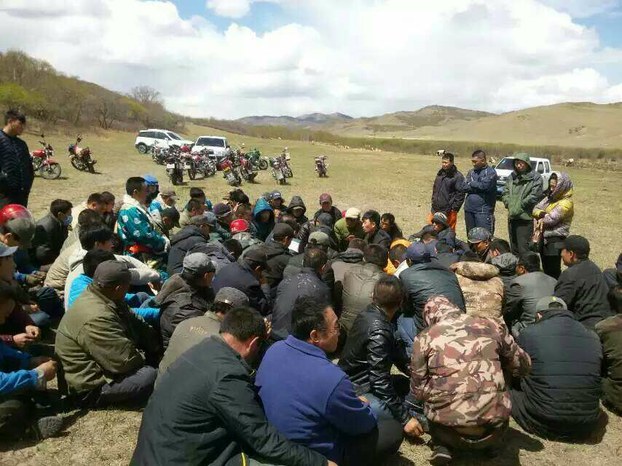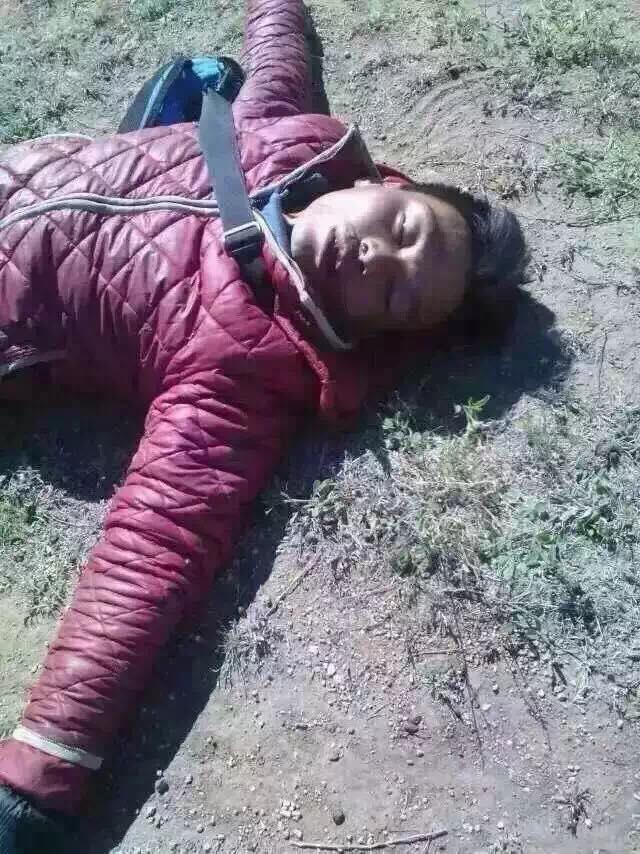As
Chinese authorities intensify their
economic exploitation through
arbitrary expropriation of grazing
lands in Southern (Inner) Mongolia,
protests by rural Mongolian herders
have spread across Southern
Mongolia’s pastoralist communities.
Over the past week, Mongolian
herders staged protests on at least
five separate occasions in their
respective Banners (equivalent to a
county) demanding the right to their
grazing lands. At least 17 herders
were arrested and many beaten up by
police.
Since
early May this year, Mongolian
villagers from Tulee Gachaa (gachaa
is equivalent to village), located
in Mingren Som (som is equivalent to
township), belonging to Naiman
Banner (banner is equivalent to
county) of eastern Southern (Inner)
Mongolia’s Tong Liao Municipality
have staged a protest against the
expropriation of their lands by a
government backed Chinese-run
forestry company called “Xing Long
Gao Forestry”. The villagers have
lost about 4,000 hectare of land to
the forestry company since 2011.
On
May 9, 2015, five representatives
from the community were arrested
while they visited Beijing to appeal
to the Central Government of China
about their grievances. They were
taken back to Naiman Banner and put
under detention immediately. On May
12, 2015, three more Mongolian
villagers were arrested from Tulee
Gachaa and detained for protesting
the land grab. Almost a month has
passed yet all eight villagers are
still being detained in an
undisclosed place. Family members
are denied the right to visit them.
The authorities simply told the
family members that they are being
held for “causing public
disturbances”.
On
May 28, more than a hundred
Mongolian herders representing 40
some households from Gegeen-engger
Village of Guilestei Gachaa in
eastern Southern Mongolia’s Bairin
Right Banner (“ba lin you qi” in
Chinese) blocked a construction site
on State Highway 303 that was
running through the herders’ grazing
land. Herders demanded the halt of
construction and compensation for
the loss of grazing lands.
More
than 40 police arrived to the scene
and carried out the crackdown.
Electric batons and pepper spray
were used. Three herders were
arrested and taken away by police.
Among the many beaten up, one woman
suffered from severe bleeding and
was hospitalized. Four other
herdswomen were injured. Police
confiscated herders’ cell phones
used to take pictures and videos of
the scene of crackdown.
Since
mid-May, 2015, over 200 Mongolian
herders from Bayan-undur Som of
eastern Southern Mongolia’s
Ar-Horchin Banner (“a lu ke er qin
qi” in Chinese) staged a sit-in
protest on grazing land that was
confiscated by the local government.
On May 31, 2015, five herders were
arrested and detained for organizing
the sit-in. Tensions have escalated
as the local authorities attempted
to forcibly drive away the herders
who returned to their grazing lands
and grazed their livestock on the
so-called “protected area”.
The
local herders informed the Southern
Mongolian Human Rights Information
Center (SMHRIC) that the local
government expropriated a large
tract of grazing land totaling about
94,000 hectares in 1997. It was
classified a “protected area” and
herders and their livestock were
forcibly displaced from the land. In
2000, defiant herders returned to
the land and reclaimed their right
to continue their traditional way of
life. Local authorities mobilized a
large number of riot police and
security personnel to crackdown on
the herders. Livestock were shot
dead, and herders beaten up and
fined.
Last
week, nearly a hundred Mongolian
herders from western Southern
Mongolia’s Urad Middle Banner
marched toward the Banner capital
Haliut Town protesting the
expropriation of grazing land for
mining. A video clip SMHRIC received
from the herders shows police
rushing to the scene and carrying
out arrests. The herder’s leader,
Xiaolong, was taken away by police
and is still under detention.
“This
is a busy season for us”, a herder
who asked not to be identified told
SMHRIC over the phone, “we are
planning to have a larger protest
after this busy season is over.”
On
June 3, 2015, herders from
Ulzeimurun Som of eastern Southern
Mongolia’s Zaruud Banner (“zha lu te
qi” in Chinese) were attacked by the
Banner’s Forestry Bureau personnel
and “Livestock Grazing Ban
Taskforce” (“jin mu dui” in Chinese)
while they were grazing their
animals on their own lands.
The
video clips and pictures SMHRIC
received from the herders show that
more than a dozen police vehicles
arrived to the scene to put down the
protest. According to a written
communication from the community, a
herder named Buyan was beaten
unconscious by the Forestry Bureau
personnel and local police while he
tried to stop them from confiscating
his livestock. The police offered no
explanation for their seizure of his
animals. Currently he is under
emergency medical treatment in the
Banner hospital.







 Beyond
Great Walls: Environment, Identity, and Development on the Chinese
Grasslands of Inner Mongolia
Beyond
Great Walls: Environment, Identity, and Development on the Chinese
Grasslands of Inner Mongolia China's
Pastoral Region: Sheep and Wool, Minority Nationalities, Rangeland
Degradation and Sustainable Development
China's
Pastoral Region: Sheep and Wool, Minority Nationalities, Rangeland
Degradation and Sustainable Development The
Ordos Plateau of China: An Endangered Environment (Unu Studies on
Critical Environmental Regions)
The
Ordos Plateau of China: An Endangered Environment (Unu Studies on
Critical Environmental Regions)